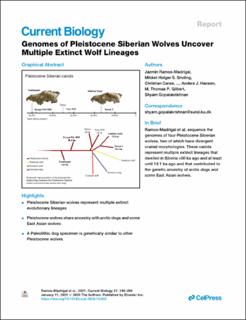| dc.contributor.author | Ramos-Madrigal, Jazmín | |
| dc.contributor.author | Sinding, Mikkel Holger Strander | |
| dc.contributor.author | Carøe, Christian | |
| dc.contributor.author | Mak, Sarah Siu Tze | |
| dc.contributor.author | Niemann, Jonas | |
| dc.contributor.author | Samaniego Castruita, José A. | |
| dc.contributor.author | Fedorov, Sergey | |
| dc.contributor.author | Kandyba, Alexander | |
| dc.contributor.author | Germonpré, Mietje | |
| dc.contributor.author | Bocherens, Hervé | |
| dc.contributor.author | Feuerborn, Tatiana R. | |
| dc.contributor.author | Pitulko, Vladimir V. | |
| dc.contributor.author | Pavlova, Elena Y. | |
| dc.contributor.author | Nikolskiy, Pavel A. | |
| dc.contributor.author | Kasparov, Aleksei K. | |
| dc.contributor.author | Ivanova, Varvara V. | |
| dc.contributor.author | Larson, Greger | |
| dc.contributor.author | Frantz, Laurent A.F. | |
| dc.contributor.author | Willerslev, Eske | |
| dc.contributor.author | Meldgaard, Morten | |
| dc.contributor.author | Petersen, Bent | |
| dc.contributor.author | Sicheritz-Pontén, Thomas | |
| dc.contributor.author | Bachmann, Lutz | |
| dc.contributor.author | Wiig, Øystein | |
| dc.contributor.author | Hansen, Anders J. | |
| dc.contributor.author | Gilbert, Marcus Thomas Pius | |
| dc.contributor.author | Gopalakrishnan, Shyam | |
| dc.date.accessioned | 2021-02-23T12:44:05Z | |
| dc.date.available | 2021-02-23T12:44:05Z | |
| dc.date.created | 2021-01-10T20:37:28Z | |
| dc.date.issued | 2020 | |
| dc.identifier.citation | Current Biology. 2020, 31 (1), 198-206. | en_US |
| dc.identifier.issn | 0960-9822 | |
| dc.identifier.uri | https://hdl.handle.net/11250/2729816 | |
| dc.description.abstract | Extant Canis lupus genetic diversity can be grouped into three phylogenetically distinct clades: Eurasian and American wolves and domestic dogs.1 Genetic studies have suggested these groups trace their origins to a wolf population that expanded during the last glacial maximum (LGM)1, 2, 3 and replaced local wolf populations.4 Moreover, ancient genomes from the Yana basin and the Taimyr peninsula provided evidence of at least one extinct wolf lineage that dwelled in Siberia during the Pleistocene.35 Previous studies have suggested that Pleistocene Siberian canids can be classified into two groups based on cranial morphology. Wolves in the first group are most similar to present-day populations, although those in the second group possess intermediate features between dogs and wolves.67 However, whether this morphological classification represents distinct genetic groups remains unknown. To investigate this question and the relationships between Pleistocene canids, present-day wolves, and dogs, we resequenced the genomes of four Pleistocene canids from Northeast Siberia dated between >50 and 14 ka old, including samples from the two morphological categories. We found these specimens cluster with the two previously sequenced Pleistocene wolves, which are genetically more similar to Eurasian wolves. Our results show that, though the four specimens represent extinct wolf lineages, they do not form a monophyletic group. Instead, each Pleistocene Siberian canid branched off the lineage that gave rise to present-day wolves and dogs. Finally, our results suggest the two previously described morphological groups could represent independent lineages similarly related to present-day wolves and dogs. | en_US |
| dc.language.iso | eng | en_US |
| dc.publisher | Elsevier | en_US |
| dc.rights | Attribution-NonCommercial-NoDerivatives 4.0 Internasjonal | * |
| dc.rights.uri | http://creativecommons.org/licenses/by-nc-nd/4.0/deed.no | * |
| dc.title | Genomes of Pleistocene Siberian Wolves Uncover Multiple Extinct Wolf Lineages | en_US |
| dc.type | Peer reviewed | en_US |
| dc.type | Journal article | en_US |
| dc.description.version | publishedVersion | en_US |
| dc.source.pagenumber | 198-206 | en_US |
| dc.source.volume | 31 | en_US |
| dc.source.journal | Current Biology | en_US |
| dc.source.issue | 1 | en_US |
| dc.identifier.doi | 10.1016/j.cub.2020.10.002 | |
| dc.identifier.cristin | 1868417 | |
| dc.description.localcode | ª 2020 The Authors. Published by Elsevier Inc. This is an open access article under the CC BY-NC-ND license (http://creativecommons.org/licenses/by-nc-nd/4.0/). | en_US |
| cristin.ispublished | true | |
| cristin.fulltext | original | |
| cristin.qualitycode | 2 | |

